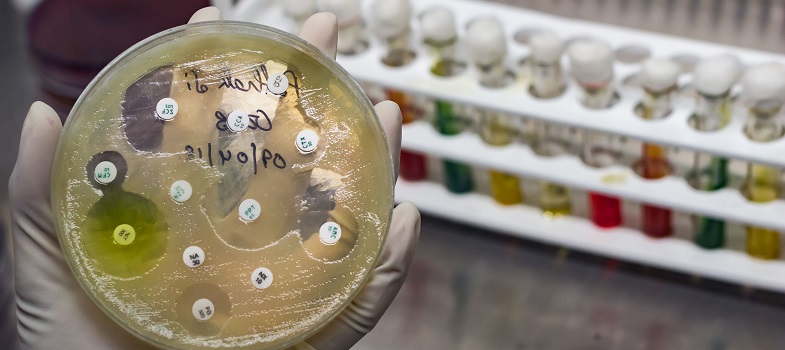Glossary
Special | A | B | C | D | E | F | G | H | I | J | K | L | M | N | O | P | Q | R | S | T | U | V | W | X | Y | Z | ALL
A |
|---|
antimicrobial susceptibility testing (AST)A
microbiological test to determine whether bacteria are susceptible or resistant
to an antibiotic. | |
C |
|---|
Clinical and Laboratory Standards Institute (CLSI)A
US-based organisation that promotes international laboratory standards and
guidelines for performing antibiotic susceptibility tests. | |
clinical breakpointA discriminating concentration used in the interpretation of susceptibility tests to define isolates as susceptible or resistant. | |
control strainsBacterial
isolates of known antibiotic sensitivity profile included in antimicrobial susceptibility testing (AST) to ensure that
the test is performed correctly. | |
D |
|---|
doubling dilutionsA
series of dilutions made so that the concentration of the antibiotic is reduced
by one half for each dilution step made. | |
E |
|---|
European Committee on Antimicrobial Susceptibility Testing (EUCAST)A
Europe-based organisation that promotes international laboratory standards and
guidelines for performing antibiotic susceptibility tests. | |
G |
|---|
genotypic methodsMethods based on the detection of genes. | |
Gold StandardThe
best possible test for a given set of conditions. | |
I |
|---|
increased antibiotic exposure (I)A category
of isolates with a minimum inhibitory concentration (MIC) in the intermediate zone between definite susceptibility
and definite resistance to an antibiotic – as defined by EUCAST. | |
inoculumThe microorganism suspension used to inoculate (or infect) something. | |
International Standards Organisation (ISO)An
international body that has developed international quality standards for
microbiological laboratories. | |
K |
|---|
Kirby-Bauer methodThe
most commonly used disk diffusion method for antimicrobial susceptibility testing (AST). | |
M |
|---|
McFarland standardsReference standards that are used to adjust and standardise the turbidity of a bacterial
suspension. | |
minimum bactericidal concentration (MBC)The lowest concentration of antimicrobial that kills a microorganism. | |
minimum inhibitory concentration (MIC)The lowest concentration of an antimicrobial agent that inhibits the visible growth of a microorganism. | |
O |
|---|
One HealthA
concept that recognises the interdependency of human health and animal health, and
the ecosystems in which they evolve. | |
P |
|---|
pharmacodynamicsThe study of the biochemical and physiological effects of a drug on an organism. | |
pharmacokineticsThe study of drug absorption, distribution, metabolism and excretion. | |
phenotypic methodsMethods that rely on observable characteristics of the strain being tested. | |
Q |
|---|
quality proceduresActivities
and processes that identify and minimise errors and ensure laboratory quality. Examples include quality control (QC), quality assurance (QA) and quality management system (QMS). | |
R |
|---|
resistance (R)A category
of isolates with a minimum inhibitory concentration (MIC) higher than the clinical breakpoint for a given
antibiotic – as defined by EUCAST | |
S |
|---|
standard operating procedures (SOPs)A document that details how routine laboratory processes and procedures should be performed. | |
susceptible (S)A category
of isolates considered susceptible to antibiotic treatment following a standard
dosing regimen – as defined by EUCAST. | |
T |
|---|
turbidityA measure of how well light passes through a liquid. Light is scattered by particles in liquid, making them appear cloudy or turbid. Turbidity can be used to measure bacterial cell density. Samples with a high cell density will appear more turbid than those with a low cell density. | |
Z |
|---|
zone of inhibitionThe clear region around a disk impregnated with antimicrobial in a disk diffusion test. It indicates that the isolate being tested is susceptible to the antimicrobial. | |
For further information, take a look at our frequently asked questions which may give you the support you need.
If you have any concerns about anything on this site please get in contact with us here.



